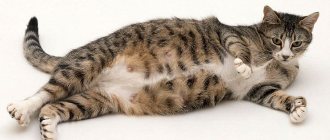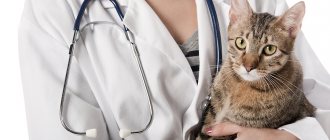Should you pay attention to the animal's sneezing?
The first sneeze is not a reason to run to the veterinarian and look for an incurable disease in the animal. Doctor Aibolit has a lot of work to do to save our little brothers even without you. But it’s not worth noticing your pet’s condition, pretending that nothing is happening. Be sure to observe the cat, recording for yourself (and later the veterinarian) how long the sneezing continues, and whether the behavior of your beloved pet has changed. Maybe you've lost your appetite? Or is your pet acting somewhat lethargic and inhibited? Additional signs of illness may have appeared, from coughing and discharge from the eyes to increased body temperature.
When is it normal for a cat to sneeze?
The reflex act of sharply inhaling deeply and exhaling forcefully through the nasal passages is called sneezing. During the process of the unconditioned reflex, various muscle groups are involved in order to carry out the strongest possible release of air from the deep parts of the lungs to cleanse the mucous membranes of unnecessary particles and irritating components. Unlike dogs, a cat can sneeze multiple times at once.
In order to clear its nasal passages, the cat actively takes a deep breath. All particles that were in the nasal passages are expelled by sneezing. Sneezing is normal and is characterized by several sets of 2-3 active sneezes. If accompanying symptoms occur, such as a runny nose, active discharge of mucous exudate from the nasal passages, lacrimation and swelling of the nose, you should consider visiting a veterinarian.
It is not too difficult to distinguish a normal condition from a pathological one. An attentive owner always notices changes in the pet’s condition in a timely manner.
A cat that sneezes from time to time and does not have parallel symptoms is absolutely healthy. The cause may be not only dust, but also various aerosols, for example, air freshener.
The signs that appear in parallel when sneezing should alert the cat owner. Acute diseases are characterized by a specific reflex of clearing the nasal passages, loss of appetite or complete refusal to feed, lethargy and apathy. And pathological processes are accompanied by a runny nose and sudden discharge of mucous exudate.
An animal may actively sneeze when the mucous membranes are irritated by aerosols, tobacco smoke, or perfumes. At the same time, the cat does not change at all in its behavior, it is active, healthy, and does not lose its appetite. The sneezing is short, single.
If a cat sneezes, are allergens the cause?
It's not just humans who are susceptible to allergies. Cats also tend to react to stimuli around them - and this happens quite often.
The following allergens can cause sneezing:
- dust (a couple of hours in an abandoned attic of a house is enough);
- pollen (a walk by the mustachioed-striped during the flowering period can result in an allergy);
- mold (living in a damp or excessively humid room is not good for the animal);
- chemicals (especially those that people use to clean a room or clean carpets);
- cat litter;
- tobacco or hookah smoke (smoking pet owners should think about the fact that they harm not only themselves, but also those around them - both people and animals);
- aroma candles;
- special aerosol sprays, etc.
Determining what caused a cat's allergies is not so easy. However, with careful analysis, you can notice what surrounds your pet, and then it will be possible to remove the allergen from the animal’s living environment as potentially dangerous.
This will reduce the risk of all kinds of allergic reactions and will not give you a reason to sneeze. As preventative measures, we recommend not using aerosols in the presence of your pet, not cleaning the bowl and litter tray with any chemical-based products, and not purchasing low-quality litter.
If your cat suddenly starts sneezing, take stock of the situation and find what exactly it came into contact with immediately before the onset of the allergy.
Preventive actions
Sneezing helps the kitten get rid of irritants trapped in the nasal cavity. As already mentioned, the phenomenon itself does not cause problems either for the animal or for its owner. However, obsessive sneezing causes considerable concern for cat owners.
Therefore, preventive measures can reduce the likelihood of such an unpleasant situation occurring:
- Carrying out wet cleaning in the apartment will help get rid of dust.
- Smoking in a room separate from where the animal is will protect your four-legged friend from allergies to tobacco smoke.
- Do not spray perfumes or other aerosols in the presence of a cat.
- It is necessary to perform anthelmintic measures and give your cat regular vaccinations.
- Be sure to clean the animal's nose, ears and teeth.
- It is worth protecting kittens from drafts and hypothermia.
Attentiveness and concern for your four-legged friend will help avoid serious consequences, and in some cases can save the animal’s life.
Source: fb.ru
Foreign object caught in the respiratory tract
Typically, such an unpleasant situation is typical of young individuals, who are more playful and active. Although there are also mature animals that have not lost their playfulness and desire to play. It is extremely rare, but it happens that small objects get into the respiratory tract of pets. If you personally see that an animal has inhaled a button, a bead, a small piece of equipment or a toy, or you suspect this option, do not hesitate - go to the veterinarian. Without special medical tools and skills, you are unlikely to be able to remove the item. And remember - delay increases the risk for the life of such a dear pet.
Infection
The main symptom of an infection of the upper respiratory tract (not only in humans, but also in cats) is sneezing. This is how the animal’s body gives signals that it is infected with bacteria or viruses, which provokes sneezing. The latter can be combined with fever, various discharges from the nasal passages, sour eyes, unpleasant cough, difficulty breathing, and enlarged glands.
The most correct reaction of a cat owner is to contact an animal clinic. The veterinarian is able to accurately identify the causative agent of the infection (based on the results of the tests) and recommend competent treatment according to the weight and age of the animal.
Selecting and giving medications to a cat on your own (a careless owner can treat the animal with medications for humans) is strictly prohibited!
Dental problems
At first glance, teeth and sneezes have no points of contact. However, it is dental diseases that can cause sneezing in a cat. How to recognize that a cat is sneezing because of its teeth? Of course, ideally, go to the veterinarian.
You can recognize this problem yourself if you observe the following in an animal:
- unpleasant odor from the mouth,
- swollen or bleeding gums,
- inflammation of the oral mucosa.
In this case, if the cat is sneezing, treatment should be aimed at eliminating dental infections in the chronic stage (they often spread to the nose area and cause prolonged sneezing for no apparent reason). Therefore, it is important to monitor your pet's dental health.
Diseases of which sneezing is a symptom
Cats are susceptible to various diseases. Protecting an animal from them is the task of a loving and caring owner. However, sometimes even the measures taken do not help, and the pet gets sick. There are various pathologies, one of the manifestations of which is sneezing.
Infectious diseases
The most common infections found in cats.
Rhinotracheitis
An acute disease of viral etiology that affects the respiratory system and eyes. A cat can become infected from another infected animal or a person who has been in contact with cats carrying the virus. Virions are present in various biological fluids of an infected animal; the infection can be transmitted through the air, through food, hygiene and care items.
A sick animal has a fever, cough, and sometimes vomiting. The eyes fester and become swollen, purulent discharge flows from the nostrils.
Read more in the article Rhinotracheitis in cats.
Calicivirus
A very common infectious disease of a viral nature in cats. Characterized by the following symptoms:
- temperature increase;
- conjunctivitis;
- formation of ulcers on the mucous membrane of the oral cavity and nasopharynx, tongue;
- sneezing;
- depression, lethargy, apathy;
- serous discharge from the eyes and nose;
- copious flow of saliva.
A cat can become infected from an infected animal. The pathogen is transmitted by airborne droplets, contact and nutrition.
Distemper or panleukopenia
An extremely dangerous viral disease characterized by high contagiousness. This infection occurs with fever, vomiting (green or greenish-yellow, sometimes with blood), runny nose and cough. In the acute stage, the cat has frequent shallow breathing and dry oral mucosa. The animal can sit over the water bowl, but not touch it. It wants to drink due to severe dehydration of the body, but cannot due to severe pain in the abdomen. During the illness, the cat loses a lot of weight, the fur comes out and becomes dull.
The mortality rate when infected with panleukopenia reaches 90%. If the cat survives 3-4 days from the onset of acute clinical symptoms, then most likely it will pull through.
Chlamydia
A common, very dangerous and long-lasting infectious disease. The eyelids become very swollen, mucus flows from the nose and eyes. The disease is treated with antibiotics, the veterinarian prescribes them and determines the required dosages. The most commonly used drugs are tetracycline or erythromycin. Conjunctivitis is treated with tetracycline ointment, which should be placed behind the eyelid 3-4 times. The course is at least two weeks, even if the symptoms have disappeared, it is not so easy to kill chlamydia that affects intracellular environments. Therefore, it is necessary to carry out the course of treatment to the end.
Toxoplasmosis
An infectious disease caused by protozoa leading a parasitic lifestyle. Cats are the main hosts of these parasites. They can become infected by eating rodents that carry the parasite. Infection is also possible if the cat simply walks on the street, where it “gets acquainted” with the excrement of other animals.
Toxoplasmosis in cats manifests itself as a significant increase in temperature, vomiting, enlarged lymph nodes, and lack of appetite. The animal becomes lethargic and tries to hide in a secluded place. The eyes become inflamed and watery, the cat may cough or sneeze. Sometimes there are convulsions.
Read more in the article toxoplasmosis in cats, and we also recommend reading about this disease in humans to find out whether it is possible to become infected with it and what cats have to do with it.
Bordetellosis
A disease caused by a bacterial infection. It affects the respiratory system: at first the cat has difficulty breathing and nasal discharge. Because of them, the fur near the nostrils sticks together, the cat begins to snore loudly, trying to breathe fully, and becomes very irritable. The cat is coughing violently and increasingly thick discharge is flowing from the nose. The disease also affects the eyes: conjunctivitis develops, they swell, and pus appears. When the first signs of this disease appear, the cat should be shown to a veterinarian and treatment should begin. The disease greatly weakens the immune system.
Mycoplasmosis
A highly contagious infectious disease caused by mycoplasma bacteria. It is characterized by inflammation of the eyes, dysfunction of the respiratory and genitourinary systems, and the musculoskeletal system.
It is transmitted from infected animals by airborne droplets, household, nutritional and sexual contact. Transmission also occurs during childbirth from mother cat to kitten.
Asthma
A “human” disease such as bronchial asthma also occurs in cats. It also affects the respiratory tract, causing increased bronchial hyperresponsiveness. A cat with asthma begins to cough, sneeze, wheeze, and has difficulty breathing. Most often it has an allergic etiology. Inhalation of cold air and a stressful state can also trigger an attack.
Parasitic infestations
When helminths enter an animal’s body, they can be found not only in the gastrointestinal tract, but also in other organs and systems. For example, nematodes from the genus Dirofilaria infect the myocardium, causing a variety of symptoms. The carriers of the larvae of this worm are blood-sucking insects, most often mosquitoes. A cat can become infected after being bitten by an insect that was the intermediate host of the parasite.
With dirofilariasis, the cat becomes lethargic, refuses to eat, and often sneezes and coughs. It is predominantly dry, with clearly audible wheezing.
Read more in the article about worms in cats and kittens, and also familiarize yourself with the rules of deworming, which must be carried out in a timely manner to keep your pet healthy.
Oncology
Cancer spares neither people nor cats. The development of a cancerous tumor in the upper respiratory tract or nasal passages may also be the reason why your cat is sneezing frequently. In addition, symptoms such as lethargy, apathy, lack of appetite, and difficulty breathing are observed. Cats often develop bad breath.
Asthma in four-legged animals
Asthma is a disease that occurs not only in humans. Veterinarians and pet owners are increasingly encountering this disease. Asthma in a chronic state against the background of provocateurs (tobacco smoke, pollen from flowering plants, fluff, dust, chemical sprays and even the banal smell of the housewife or owner’s perfume) can cause an attack accompanied by sneezing and coughing, when the animal finds it difficult to breathe normally.
The first aid in such a situation will be the following: take the cat and hold it for several minutes over hot steam, but not boiling water! Do this very carefully: do not burn the animal. Hold the cat tightly: the animal may escape and accidentally scald you and itself. It will be safer if you use a steam inhaler. This treatment will help open the passages in the bronchi and stop an asthma attack in your pet.
Even a one-time asthmatic attack requires consultation with a veterinarian so that he can prescribe the appropriate medications for the animal to treat the disease.
Stool disorder.
For a person, stool disorder is nothing more than a nuisance; for a kitten, this is the first indicator that should sound the alarm. This, of course, could be a banal failure of the intestines due to stress, or as they say, “I ate something wrong,” or it could be the beginning of a serious illness. No animal is immune from disease and illness, so you need to know basic things about diarrhea. Loose stools can indicate many problems. Maine Coons suffer from this no less often than other cats, which also applies to kittens.
Dangerous foods for Maine Coons include:
- fatty, spicy foods, including vegetable oils;
- spoiled food;
- carrion;
Severe poisoning and diarrhea are possible when consuming:
- household chemicals;
- some plants (dieffenbachia, schefflera, ivy, hyacinth)
- paints;
- resinous substances;
- petroleum products;
- alcohol;
- mushrooms
First aid for an adult animal and a kitten is necessary to avoid dehydration. Mild diarrhea can be prevented at home by following the advice of veterinarians:
- Limit food or do not feed for 12-24 hours
- Provide free access to boiled water
- Give activated carbon / smecta / interosgel (infused through a syringe without a needle)
- Drink chamomile infusion, cooled to room temperature
If the situation has not changed within a day, the diarrhea continues or intensifies, then the pet must be shown to a veterinarian.
Heartworm infection in a cat
It is extremely rare, but still occurs in practice, that such cute creatures as cats become infected with heartworms when they find themselves in places with very high air humidity and a maximum number of mosquitoes. Why these insects? Yes, because it is through their bite that the parasite is transmitted to the pet. The heartworms themselves, once in the cat’s body, affect the right side of the heart, as well as the lungs. As a result, the arteries become clogged, it becomes difficult to breathe, and coughing and sneezing begins. And the end is often sad - a heart attack and death.
To protect your mustachioed pet from these parasites, follow the following preventive measures:
- maintain strong immunity,
- ensure proper diet and lifestyle.
And when traveling outdoors, you can prepare a special mosquito repellent in advance (dilute citronella with plain water). This composition will reduce the risk of parasite infection to a minimum, which will undoubtedly preserve the health and, of course, the life of your pet. This is just the simplest measure to prevent infection with malicious worms. Your veterinarian will cover this topic in more detail.
Sneezing with bloody discharge from the sinuses of a cat
If you notice that your pet is sneezing with droplets of blood mucus, immediately contact a veterinary clinic. This symptom is very dangerous and can indicate a serious illness (from a severe fungal infection and extensive damage to the animal’s nasal sinuses due to the prolonged presence of a foreign object in them or a burn of the mucous membrane to leukemia and nasal cancer).
A professional will examine your four-legged pet, prescribe the necessary tests and diagnostic examinations and, based on their results, tell you what your pet’s illness is.
In any of the above cases, if there are several pets in your home, the person suffering from sneezing must be protected from communication with other animals (place him in quarantine so as not to infect others).
So, if your cat is sneezing, what exactly to treat, the veterinarian will tell you. There are many reasons for this condition, and most of them are far from harmless. Don’t let the symptoms and finding out the true disease take their course. This will allow you to react in a timely manner and adequately to the situation.
If you want to minimize the risk of various diseases in your pet, provide him with proper care. Do routine vaccinations of the animal (according to its stage of development), feed it well, and take it to the veterinarian for preventive examinations.
Your care will help your cat be healthy and never sneeze!











